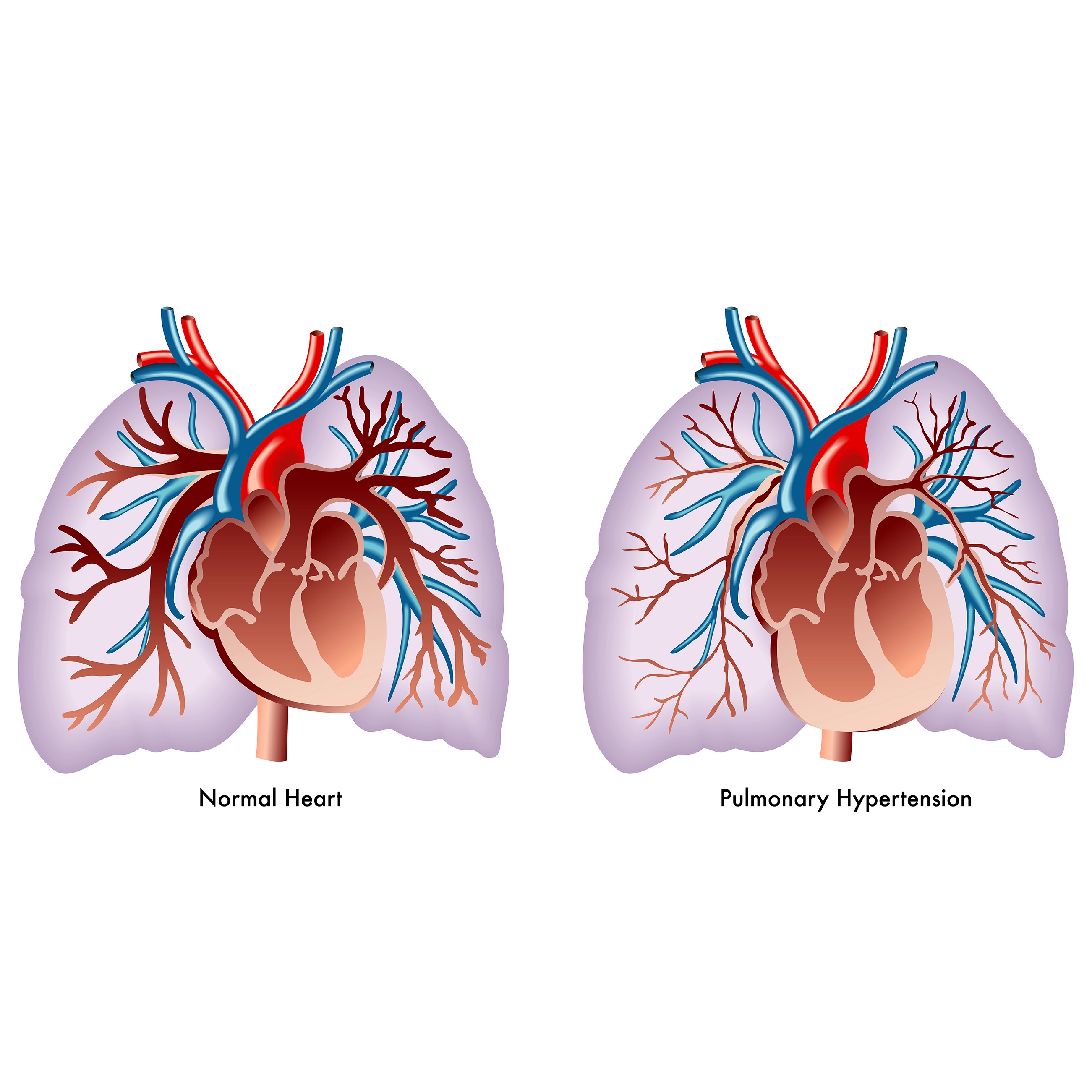ERS 2025: Pulmonary Hypertension: Highlights
Pulmonary Hypertension Associated with Interstitial Lung Disease in the PVRI GoDeep Meta-Registry
Presenter: Athiththan Yogeswaran (Germany)
Pulmonary hypertension (PH) associated with interstitial lung disease (ILD) is linked with high mortality and morbidity, however approved treatments are lacking. Data of 859 PH-ILD patients (median age: 67 years) enrolled in the PVRI GoDeep meta-registry was analysed. Patients were stratified by pulmonary vascular resistance (PVR) into moderate (≤5 Wood Units [WU]) or severe (>5 WU). Lung function was markedly reduced (FVC 57%[44,72] predicted , DLCO 27%[20,38] predicted). Severe PH-ILD was present in 62% cases and was associated with poor survival (63%, 29%, and 18% at 1, 3, and 5 years). PDE5 inhibitors(PDE5i) used in 69% of patients was associated with improved survival in severe PH-ILD (HR 0.607 [0.418,0.880] ), PH-IIP(HR 0.327[0.274,0.390]), PH-IPF(HR 0.376[0.267,0.530] ) and PH-IPF with antifibrotic therapy(HR 0.124[0.022,0.699]).
In conclusion, PH severity was observed to significantly influence survival in PH-ILD. Use of PDE5i therapy may be linked to improved outcomes in severe PH-ILD, PH-IIP, and PH-IPF, highlighting the need for further evaluation in controlled trials.
Clinical Significance of Bendopnea in Patients with COPD and its Role in Screening for Pulmonary Hypertension Associated with COPD
Presenter: Toshitaka Shomura (Japan)
In a study of 99 COPD patients, bendopnea, a symptom commonly associated with heart failure, was evaluated as a potential screening tool for pulmonary hypertension (PH) associated with COPD. Patients were grouped into those with bendopnea (n=17) and without (n=82), and clinical measurements were compared. The FEV1/FVC ratio was significantly lower in the bendopnea group (45.2% vs. 55.6%, p<0.05). Bendopnea showed negative correlations with FEV1/FVC (p = -0.306) and V50 (p = -0.3445). PH-related markers such as DLCO <40%, %FVC/%DLCO >1.5, pulmonary artery/aortic diameter(PA/A) ratio >1, BNP >33 pg/mL, tricuspid regurgitation pressure gradient (TRPG) >35 mmHg and PH diagnosis were more prevalent among those with bendopnea (p<0.05). It was concluded that bendopnea may serve as a useful physical indicator for PH screening in COPD patients.
From Sit to Stand: A Simple Test Predicts Adverse Outcomes in Pulmonary Hypertension
Presenter: Christina Kronberger (Austria)
In a prospective study of 117 pulmonary hypertension (PH) patients (mean age 66±14 years, 56% female, mean one-minute sit-to-stand test [1-min STST] repetitions 17+6), the prognostic value of 1-min STST was evaluated. Over a median follow-up of 2.2 years, 59 patients had an adverse event. Each additional STST repetition resulted in a 6% reduction in event risk (HR=0.94 per repetition, 95% CI 0.90–0.98, p=0.003), remaining significant after adjusting for confounders (HR=0.95, 95% CI 0.90–0.99, p=0.037). Patients with< 14 repetitions had a significantly higher risk of adverse long term outcomes (log rank p=0.001). The 1-min STST was concluded to independently predict adverse outcomes in PH and hence can be a useful parameter for risk stratification.
Assessment of Pulmonary Arterial Hypertension Management at the Time of Death: A Comparative Study between France and the UK
Presenter: Athénaïs Boucly (France)
This study evaluated management of pulmonary arterial hypertension (PAH) at the last follow up before death to assess adherence to ESC/ERS guidelines regarding parenteral prostacyclin analogue (PCA) use in high-risk PAH patients by analysing data from the French PH Registry and Imperial College London between 2009 and 2022. After a median follow up of 2 years, out of 1924 French and 558 English PAH patients who died, only 9% patients from each cohort were on triple combination therapy including i.v/s.c PCA. Oral dual combination therapy was received by 43% and 44% in both cohorts, increasing to 51% in recent years (>2020). In the French cohort, at last follow-up, 36% and 34% of patients were at intermediate-high and high risk of death respectively; only 15% and 20% received triple therapy. These findings were also noted in subset of idiopathic/heritable or drug-induced PAH. It was concluded that most PAH patients were not receiving guideline-recommended maximum therapy at the time of death.
Drugs and Toxic-Associated Pulmonary Arterial Hypertension, Prognosis and Management in the Current Era of Treatment: Results from the REHAP Registry
Presenter: Laura Lago Lagunas (Spain)
In the Spanish REHAP registry study, drug and toxin-induced pulmonary arterial hypertension (D&TPAH) patients were compared with idiopathic (IPAH) and hereditary PAH (HPAH) groups. Demographics were similar, though D&TPAH was diagnosed more quickly. Dyspnea was more prevalent in the D&TPAH group (94% vs 90%). Functional, hemodynamic, and echocardiographic assessments were comparable between the groups, with slightly lower values in D&TPAH.
Treatment typically involved monotherapy or dual therapy in both groups. Five-year outcomes were similar, with no statistically significant difference in survival (p=0.697), despite an early advantage for IPAH/HPAH followed by a reversal favoring D&TPAH. In conclusion, while D&TPAH group initially demonstrated lower survival rates, their long term outcomes are similar to that of IPAH/HPAH patients.
Long-Term Survival in Patients with Pulmonary Arterial Hypertension with Comorbidities Stratified by Risk Classification
Presenter: Misaki Kanezawa (Japan)
Upfront combination therapy is guideline recommended and is correlated with improved survival in patients with classical pulmonary arterial hypertension (PAH), while its use is limited in PAH patients with comorbidities due to their intolerance for vasodilators. However, the long term prognosis by risk stratification remains unclear. In this study of 114 PAH patients, classical PAH (n=42) and PAH with comorbidities (n=72) were compared using the 3-strata risk model. Upfront combination therapy, including with parenteral prostaglandin was more common in classical PAH than in PAH with comorbidities (83% vs. 9%, p<0.001) with the baseline mean pulmonary artery pressure higher in classical PAH (49±16 vs. 39±12 mmHg, p<0.001). The 10-year survival rate was significantly better in classical PAH (96%; low 100%, intermediate 96%, and high risk of death 100%, p=0.882) versus PAH with comorbidities (46%; low 100%, intermediate 46%, and high risk of death 0%, p=0.005). The lower survival in PAH with comorbidities may be due to fewer patients being able to tolerate combination therapy.
Evaluating the Prognostic Accuracy of ESC/ERS Risk Stratification Models in Pulmonary Arterial Hypertension Patients in Saudi Arabia
Presenter: Abdullah Alharbi (Saudi Arabia)
Despite available therapies, PAH survival remains suboptimal, underscoring the need for improved risk stratification. In this retrospective study of 159 pulmonary arterial hypertension (PAH) patients (80% female, mean age 44 years) at King Abdulaziz Medical City, Saudi Arabia, the prognostic performance of the European Society of Cardiology/European Respiratory Society(ESC/ERS) 3-strata and 4-strata risk models was compared. At baseline, both models showed similar discrimination for survival (C-statistic ~0.66, AICs~385). However, at follow-up, the 4-strata model significantly outperformed the 3-strata model [C-statistic (0.75 vs. 0.67) AIC (368.6 vs. 378.5)] providing a more differentiated survival prediction. Notably, the 4-strata model better differentiated intermediate-risk subgroups by survival estimates- intermediate low(1-year: 100%, 3- year: 98%, 5-year: 79%) vs. intermediate-high (1-year: 95%, 3-year: 68%, 5-year: 66%) compared to single survival estimates in the 3 strata model (1-year: 97%, 3-year: 80%, 5-year: 70%). The 4-strata model was concluded to be superior for follow-up prognostic stratification in this cohort.
Ref: European Respiratory Society Congress 2025, September 27 - October 1, Amsterdam, Netherlands




